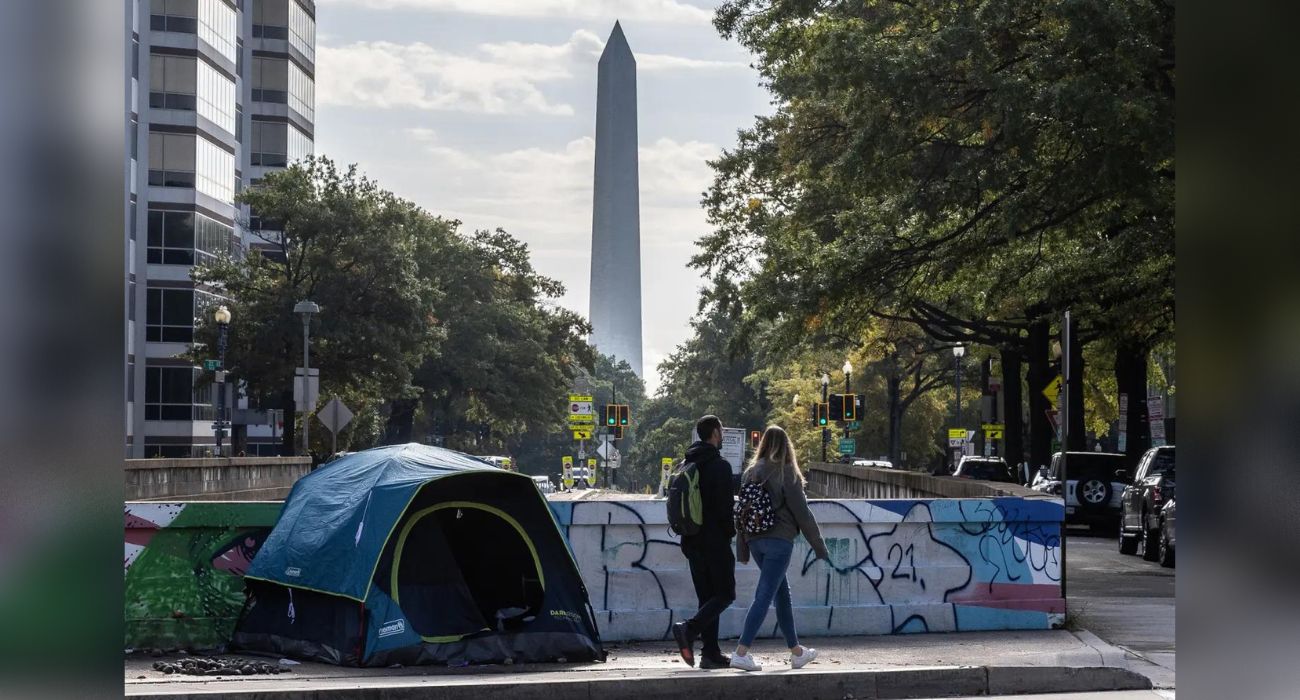The number of homeless encampments in Washington, D.C., has grown to an estimated 120 over the past two years.
During the COVID-19 pandemic, both city and federal governments eased enforcement measures against vagrancy, and more tent cities sprang up across the nation’s Capital.
The New York Post recently found at least 35 vagrants residing at a National Park Service site two blocks from the White House. More than 20 were abiding in the green spaces surrounding the State Department complex, and five were across the street from the Watergate Hotel.
These sites accounted for less than 5% of the estimated 120 encampments across the nation’s Capital, representing at least a 30% rise from before the pandemic.
Daniel Kingery, who has been homeless in D.C. for over two years, said the number of those living on the street has grown since President Biden’s inauguration. He added that those who donate food and resources to the homeless make it easier for them to remain comfortable in their vagrancy.
“There’s so much [donated] food coming into this park, there’s not enough people to eat it. So they’ll give it to the birds or throw it away,” said Kingery, 61.
“All of these bleeding-heart organizations bring pretty much the same thing to the same park, and it usually gets thrown away,” Kingery said. He mentioned sleeping bags and ponchos and said once in a while, he has even thrown away “brand-new blankets.”
He claimed, “You would find very few people who come to live in this park who are hungry or malnourished.”
Kingery added that the increasing numbers of homeless people have made the Capital’s streets more dangerous.
“The people that are accumulating here tend to be a little more violent and a little more openly hostile to the tourists,” he said.
“The hospitals in which they should be housed don’t have the insurance money to keep them in there,” he continued. “So, they just turn them loose.”
Vagrancy and the erratic or even dangerous behavior that follows has adversely impacted local businesses.
“We have homeless people on drugs come in here all the time,” said Hailey Yokley, 17, a manager at a Joe & The Juice coffee shop in McPherson Square. “They come in screaming, and it scares people.”
Shane Carnahan, 32, a bartender at the Georgia Brown’s restaurant, said he had called police multiple times to deal with troublesome tent-city residents.
“They’ll come here and make a little scene,” he said. “Sometimes they come in crazy and shaking their a–, and we have to call the cops.”
Tourists from both the United States and elsewhere expressed shock at the state of vagrancy in America’s capital. “I’m just in shock,” said Devin McCants, 28, a visitor from Atlanta. “There are tents everywhere here … it’s crazy.”
Elvis Shu, 39, a first-time visitor from Cameroon, said, “‘The land of milk and honey’ — it means that in America, you don’t lack anything. I know people don’t get hungry here, so I’m surprised indeed.”
“We didn’t expect to see the homeless here near the White House,” said Moti, 48, a vacationer from Israel.
His wife, Orli, 54, said, “I thought it was a rich city. It’s a Democrat here in the White House, and the Democrats are more socialist, right?”
In July, D.C. City Council passed the Human Rights Enhancement Amendment Act, an amendment to the Human Rights Act of 1977, which prohibits discrimination against the homeless and was perceived by some to enable the homeless to continue living on the street.
“It’s wicked, and it’s medieval,” said Robert Westover, 59, a longtime D.C. resident. “We’re really letting people suffer on the street like animals? Somehow that’s progressive?”
“We’re just disgusted by it,” he continued. “I mean, the richest location on Earth, and we can’t seem to handle a homeless situation. Really?”
Meanwhile, Dallas residents also contend with vagrancy in their own neighborhoods.
Roughly 4,000 homeless individuals reside in Dallas County alone, according to the 2022 Point-in-Time (PIT) count. About one in seven suffer from severe mental illnesses.
In August, a vagrant wandered into the bathroom of a girls’ school in Fort Worth after a door failed to close properly. More on that story can be found here.







Dems don’t want to fix it. They want everyone to be homeless. Except them and they’re Globalist Elite sponsors.
Dems don’t want to fix it? Well, Republicans want to make it worse fr political gain. Why we can’t work together and try to find solutions instead of pointing fingers is beyond me.